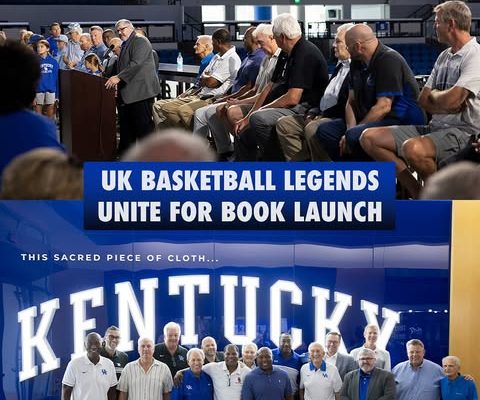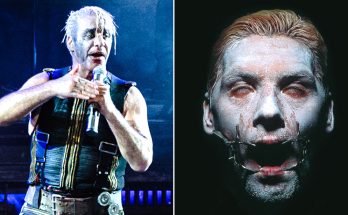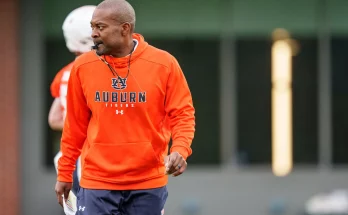Legends Return to Memorial: Wildcats Celebrate 75 Years of History, Hoops, and Heart
On August 11, inside the echoing walls of Historic Memorial Coliseum, generations of Kentucky basketball greatness gathered under one roof—not for a game, but for something just as powerful. This was a reunion of legends, a celebration of stories, and a tribute to a place that has stood for more than basketball. It was the official launch of “Memorial Coliseum: 75 Years as Monument, Stage, and Arena,” a book penned by Navy veteran and devoted Kentucky fan Kevin Cook. But the evening wasn’t just about a book—it was about legacy, about shared pride, and about what this iconic building has meant to Kentucky, both on the court and far beyond it.
The Coliseum has long been a landmark for Wildcat fans. Built in 1950 and once home to the men’s basketball program before Rupp Arena opened, it now primarily hosts women’s basketball, gymnastics, and volleyball. But its walls have witnessed decades of history: buzzer beaters, championship runs, moments of silence for the fallen, and the rise of countless UK legends. It’s not just a venue—it’s a living monument. And on that August evening, as players, coaches, fans, and family members poured into the arena, it became something even more personal: a celebration of heritage.
Kevin Cook, the author behind the commemorative book, is more than a writer—he’s a storyteller with skin in the game. A Navy veteran with a heart firmly planted in Kentucky blue, Cook took on the daunting task of chronicling not only the sports triumphs that have echoed through the Coliseum but also the deeper symbolism the building holds. Memorial Coliseum was named to honor Kentuckians who gave their lives in military service. It’s part sports arena, part shrine—a rare kind of place where the past isn’t just remembered; it’s felt.
That dual purpose is what makes the book, and the event, so special. This wasn’t just a basketball celebration. It was a gathering to reflect on sacrifice, legacy, and the way sports and service have always intertwined in the fabric of Kentucky’s identity. Players from across the decades came not just to bask in the glow of their achievements, but to pay tribute to something bigger than themselves. They came to recognize what the Coliseum gave them—and what it still gives to Kentucky today.
Walking into the event was like stepping into a living time capsule. There were legends from UK’s glory years, familiar faces who’d etched their names into Kentucky’s rich hoops history. Former players embraced like brothers. Coaches shared stories like they were back in the locker room, drawing up plays. Fans, some of whom had been attending games for 50 years or more, mingled with the athletes they once cheered from the stands. Every corner of the arena buzzed with memories.
There was laughter, of course—plenty of it. Tales of road trips, rivalries, and on-court chaos. But there were quiet moments too. Moments when the crowd turned toward the banners hanging above, or toward the memorial plaques near the entrance, and remembered why the building was named Memorial in the first place. Kevin Cook’s book leans heavily into that history, reminding readers that for all the points scored here, the most important part of the Coliseum might be what it stands for.
The book itself is a blend of narrative history, personal anecdotes, and rich archival research. Cook dug deep—not just into the wins and losses, but into the names etched into the building’s very foundation. He tells the stories of Kentuckians who never came home, and how their memory continues to shape the identity of the university and its sports culture. It’s that blend—sports and service—that gives the Coliseum its soul. And Cook captured it with the reverence and pride of someone who truly understands both.
The event honored not just the athletes, but the families and fans who have kept the tradition alive. Speakers shared memories of attending games with grandparents, or of watching their favorite players emerge from the tunnel for the first time. The Coliseum has been the backdrop to so many firsts, not just for players, but for fans: first games, first cheers, first tears. The emotion in the room was thick, the kind that only comes from a place that has meant so much to so many for so long.
Several former players took the microphone to reflect on their time in the building. Their messages were heartfelt. They spoke about walking into Memorial for the first time, feeling the weight of its history. They remembered practices that pushed them, coaches who inspired them, teammates who became family. And they spoke with gratitude—gratitude for the building, for the fans, for the experience of playing somewhere so steeped in tradition.
One of the more moving parts of the evening came when attention turned specifically to the namesakes of the building—those Kentuckians who gave their lives in military service. A moment of silence was held. The arena, usually filled with noise, fell completely quiet. It wasn’t performative. It was meaningful. Everyone in the room knew they were part of something bigger that night. Something layered. Something sacred.
The event wasn’t just about looking back. It was about appreciating what continues today. The current generation of Kentucky athletes—especially those who play their home games in Memorial—now carry the torch. Volleyball. Gymnastics. Women’s basketball. These programs keep the floor active, the lights bright, and the legacy alive. They play not just for wins, but for history. And many of them were in attendance, meeting former players, listening to the stories, and realizing they’re now part of the same lineage. For them, the night was both a celebration and a call to honor the past through the way they compete in the present.
The university, too, made clear that Memorial Coliseum remains a priority. With recent updates and ongoing investment, the arena is being prepared for another era of greatness. New facilities, new technology, and new teams—carrying on the work that began 75 years ago, when the building first opened its doors. But even as the structure evolves, the spirit remains unchanged. It’s a place of remembrance, of pride, and of performance.
As the evening came to a close, Kevin Cook received a standing ovation. The applause wasn’t just for the book, but for the effort. For the heart he poured into preserving this story. Fans lined up to get their copies signed, players hugged him like a long-lost teammate, and everyone left with a little more appreciation for the building they may have passed by a thousand times without truly seeing.
And that’s what the book does—it helps people see. To see Memorial Coliseum not just as a place where sports happen, but as a place where memory lives. It reminds readers that history isn’t confined to museums or textbooks. Sometimes it echoes through rafters, is polished into hardwood floors, or written in banners that hang quietly above empty bleachers.
The night was a reminder that Kentucky basketball isn’t just about the now—it’s about the forever. It’s about understanding that the present is built on the sweat and sacrifice of the past. And in Memorial Coliseum, that past is all around. It’s in the stories, the names, the walls, the floor. And now, thanks to Kevin Cook, it’s in a book that ensures those memories will be preserved for generations to come.
August 11 wasn’t just a book launch. It was a reunion, a reflection, and a celebration rolled into one. A reminder of where Kentucky basketball came from, and where it’s headed. The legends were home. The stories were told. And Memorial Coliseum stood tall as ever—monument, stage, and arena.



